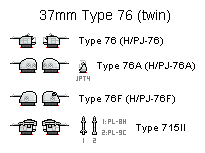37mm Type 76
History
The Type 76 37mm twin naval gun (Chinese: 76式双37舰炮) was developed by CSIC No.713 Institute in 1970s, project name "Type 715". In 1976, it adopted as Type 76 (later renamed as H/PJ-76 due to naming system change). The gun mounting is often confused with 37mm Type 61 (Chinese copy of Soviet V-11M), many sources do believe it's an improved variant of Type 61, but they are actually different systems, the development work of Type 76 started even earlier than that of Type 61. The gun mounting is capable to aim automatically under the direction of fire control, but still need in-turret crews to fire the guns. Manual operating is also available. The gun is belt feed, firing special "37mm Naval" round which is different to Soviet 37×252mm.SR round used on Type 61 and V-11M, a drum magazine contains 1600 rounds is placed belowdecks. Rate of fire is 800 rpm, effective range is about 4.5km.
Fire control system of Type 76 is H/LJP-341 radar. As for Type 76A, newer H/LJP-347 radar and JPT4 optics control station are also available.
Variants
- Type 76 (H/PJ-76) - Basic model with open-top manned turret.
- Type 76A (H/PJ-76A) - Improved variant with full-close remote-control turret, has limited close-in defense ability.
- Type 76F (H/PJ-76F) - Simplified variant of Type 76A, manually controlled by one gunner sit inside, commonly used as self-defense weapon for support ships
- Type 715II - Prototype gun-missile AA system based on the basic model, holds two short range AAM (PL-8H or PL-9C).
Used on
China:
- Type 037IS Haiqing class (Type 76 on early batches, Type 76F on late batches).
- Type 037IG Houxin class (Type 76A).
- Type 037II Houjian class (Type 76A).
- Type 053K Jiangdong class (Type 76).
- Type 053H1 Jianghu II class (Type 76, replaced by Type 715II on 555昭通(Zhaotong) after 1988).
- Type 053H2 Jianghu III class (Type 76).
- Type 053H1Q Jianghu IV class (Type 76).
- Type 053H1G Jianghu V class (Type 76A).
- Type 053H2G Jiangwei I class (Type 76A).
- Type 053H3 Jiangwei II class, before 2014 (Type 76A).
- Type 051G Luda III/IV class (Type 76A).
- Type 051B Luhai class, before 2014 (Type 76A).
- Type 052 Luhu class, before 2010 (Type 76A).
- Type 072III Yuting I class (Type 76 on early batches, Type 76F on late batches).
- Type 072A Yuting II class (Type 76F).
- Type 073III Yudeng class (Type 76).
- Type 073A Yushu class (Type 76F).
- Type 081 Wochi class (Type 76F).
- Type 903 Fuchi class (Type 76F).
- Type 904A Danyao class (Type 76F).
Thailand:
- Type 053HT/HT(H) Chao Phraya class (Type 76, upgrade to Type 76A on 053HT(H) after 2009).
Bangladesh:
- Type 053H1: BNS Osman (F18) (Type 76).
- Type 053H2: BNS Abu Bakr (F15) and BNS Ali Haider (F-17) (Type 76).
- Type 053H3: BNS Umar Farooq (F16) and BNS Abu Ubaidah (F19) (Type 76A).
- Type 010: BNS Sagar (M91) (Type 76)
Myanmar:
- Type 037IG (Type 76A)
- No.553, No.554, No.555 FACs (Type 76A)
Sri Lanka:
- Type 053H2G: SLNS Parakramabahu (P625) (Type 76A)
- SLNS Prathapa (P340), SLNS Udara (P341) (Type 76)
Pakistan:
- Jalalat class (Type 76A)
Algeria:
- Soummam (937)
Affiliated systems
Fire control:
Part description
The gun mounting has some belowdecks structure not drawn due to lacking reference, make sure to reserve at less one room space below the gun mounting when install. Basement of Type 76A may be different depend on installed ships.
